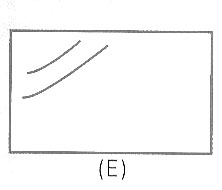Causes of paper wrinkles and solutions (2)
Before and after the bite force is uneven, the teeth are too loose, especially the ink adhesion is too large, under the action of the roller squeeze and peel force, causing the diaphragm-type folds as shown in Figure 1 (E).

4. Embossing roller teeth or delivery teeth bite teeth too small
The bite of the mouth is small. When the mouthpiece is delivered, an early bite and a late bite can cause some of the paper to bite and land on the teeth or under the teeth, causing the paper to produce large divergent folds as shown in Figure 1(F).

5. Delivery paper teeth pad uneven
Shorten the length of the paper edge when biting the paper, make the paper mouth wavy curve, when the printing paper bite the mouth can not be flatly attached to the surface of the impression cylinder, resulting in a large divergence type folds, but the position of the fold is the position of the paper clenching teeth .
6. Excessive blower mouth blower
Due to the large air volume, the middle of the back of the paper accumulates air, causing the middle of the paper to swell, and cannot contact the cardboard table in a straight line. Sometimes the bumper is adjusted too high to control the paper to reach the front gauge smoothly. When the middle bulging paper enters the front gauge and passes through the transfer teeth and is bitten by the impression cylinder bite, it is creased due to the unevenness of the bite location. The shape is large and divergent.
7. Excessive deposits on the impression cylinder
When printing on both sides of the printing, often when one side is printed and the other side of the printing is reversed, since the ink on the printing surface is not completely dried, the surface of the printing cylinder is stained with ink under the effect of the pressing force. As the printing progresses, the ink builds up unevenly, causing uneven embossing and wrinkling.
Second, the physical and chemical properties of paper
Paper is composed of plant fibers and other materials and various compounds. The plant fibers have hydroxyl groups and have a high degree of water absorption and hydrophilicity.
The water content of paper is affected by the temperature and humidity of the surrounding environment. It is a variable, and it is the first element that determines the deformation of paper.
The paper in the printing house is stored one by one, and only the four sides of the paper are in direct contact with the air. If the factory does not have constant temperature and humidity conditions, when the ambient temperature and humidity change, the paper will produce "foil", "tight edge", curl and other deformities.
If the paper is printed under these conditions, it is very easy to wrinkle due to the effect of the squeezing force and the peeling force during printing. The folds usually produced by the "foliage" side are often located on the tip of the paper and are linearly shaped as shown in Figure 1(G). The folds produced by the “tight edges†are not fixed. This is because the four sides of the paper are shrinking and the middle is wet and high convex. Under the pressure, the irregularly displaced folds of the convex parts are shown in Fig. 1(H).

(to be continued)
Swimsuit Hanger,Plastic Hanger,Hanger For Lady
Jingrun Hanger & Plastic Product Factory , http://www.hanger-manufacturer.com